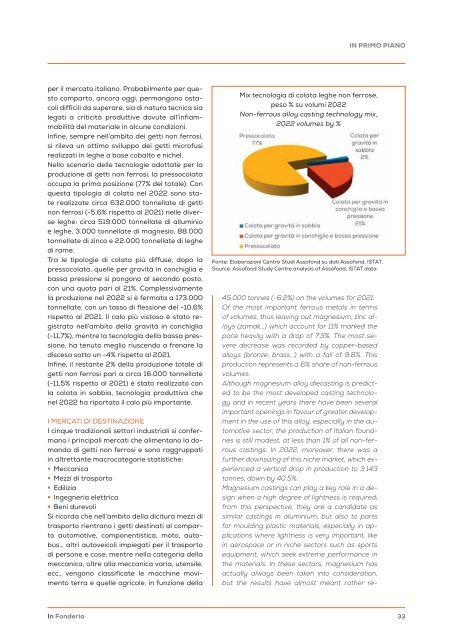In Fonderia 3 2023
Terzo numero del 2023 di In Fonderia
Terzo numero del 2023 di In Fonderia
You also want an ePaper? Increase the reach of your titles
YUMPU automatically turns print PDFs into web optimized ePapers that Google loves.
IN PRIMO PIANO<br />
per il mercato italiano. Probabilmente per questo<br />
comparto, ancora oggi, permangono ostacoli<br />
difficili da superare, sia di natura tecnica sia<br />
legati a criticità produttive dovute all’infiammabilità<br />
del materiale in alcune condizioni.<br />
<strong>In</strong>fine, sempre nell’ambito dei getti non ferrosi,<br />
si rileva un ottimo sviluppo dei getti microfusi<br />
realizzati in leghe a base cobalto e nichel.<br />
Nello scenario delle tecnologie adottate per la<br />
produzione di getti non ferrosi, la pressocolata<br />
occupa la prima posizione (77% del totale). Con<br />
questa tipologia di colata nel 2022 sono state<br />
realizzate circa 632.000 tonnellate di getti<br />
non ferrosi (-5,6% rispetto al 2021) nelle diverse<br />
leghe: circa 519.000 tonnellate di alluminio<br />
e leghe, 3.000 tonnellate di magnesio, 88.000<br />
tonnellate di zinco e 22.000 tonnellate di leghe<br />
di rame.<br />
Tra le tipologie di colata più diffuse, dopo la<br />
pressocolata, quelle per gravità in conchiglia e<br />
bassa pressione si pongono al secondo posto,<br />
con una quota pari al 21%. Complessivamente<br />
la produzione nel 2022 si è fermata a 173.000<br />
tonnellate, con un tasso di flessione del -10,6%<br />
rispetto al 2021. Il calo più vistoso è stato registrato<br />
nell’ambito della gravità in conchiglia<br />
(-11,7%), mentre la tecnologia della bassa pressione,<br />
ha tenuto meglio riuscendo a frenare la<br />
discesa sotto un -4% rispetto al 2021.<br />
<strong>In</strong>fine, il restante 2% della produzione totale di<br />
getti non ferrosi pari a circa 16.000 tonnellate<br />
(-11,5% rispetto al 2021) è stato realizzato con<br />
la colata in sabbia, tecnologia produttiva che<br />
nel 2022 ha riportato il calo più importante.<br />
I MERCATI DI DESTINAZIONE<br />
I cinque tradizionali settori industriali si confermano<br />
i principali mercati che alimentano la domanda<br />
di getti non ferrosi e sono raggruppati<br />
in altrettante macrocategorie statistiche:<br />
• Meccanica<br />
• Mezzi di trasporto<br />
• Edilizia<br />
• <strong>In</strong>gegneria elettrica<br />
• Beni durevoli<br />
Si ricorda che nell’ambito della dicitura mezzi di<br />
trasporto rientrano i getti destinati al comparto<br />
automotive, componentistica, moto, autobus…<br />
altri autoveicoli impiegati per il trasporto<br />
di persone e cose; mentre nella categoria della<br />
meccanica, oltre alla meccanica varia, utensile,<br />
ecc., vengono classificate le macchine movimento<br />
terra e quelle agricole, in funzione della<br />
Mix tecnologia di colata leghe non ferrose,<br />
peso % su volumi 2022<br />
Non-ferrous alloy casting technology mix,<br />
2022 volumes by %<br />
Fonte: Elaborazioni Centro Studi Assofond su dati Assofond, ISTAT.<br />
Source: Assofond Study Centre analysis of Assofond, ISTAT data.<br />
45,000 tonnes (-6.2%) on the volumes for 2021.<br />
Of the most important ferrous metals in terms<br />
of volumes, thus leaving out magnesium, zinc alloys<br />
(zamak...) which account for 11% marked the<br />
pace heavily with a drop of 7.3%. The most severe<br />
decrease was recorded by copper-based<br />
alloys (bronze, brass...) with a fall of 9.8%. This<br />
production represents a 6% share of non-ferrous<br />
volumes.<br />
Although magnesium alloy diecasting is predicted<br />
to be the most developed casting technology<br />
and in recent years there have been several<br />
important openings in favour of greater development<br />
in the use of this alloy, especially in the automotive<br />
sector, the production of Italian foundries<br />
is still modest, at less than 1% of all non-ferrous<br />
castings. <strong>In</strong> 2022, moreover, there was a<br />
further downsizing of this niche market, which experienced<br />
a vertical drop in production to 3,143<br />
tonnes, down by 40.5%.<br />
Magnesium castings can play a key role in a design<br />
when a high degree of lightness is required;<br />
from this perspective, they are a candidate as<br />
similar castings in aluminium, but also to parts<br />
for moulding plastic materials, especially in applications<br />
where lightness is very important, like<br />
in aerospace or in niche sectors such as sports<br />
equipment, which seek extreme performance in<br />
the materials. <strong>In</strong> these sectors, magnesium has<br />
actually always been taken into consideration,<br />
but the results have almost meant rather re-<br />
<strong>In</strong> <strong>Fonderia</strong><br />
33














